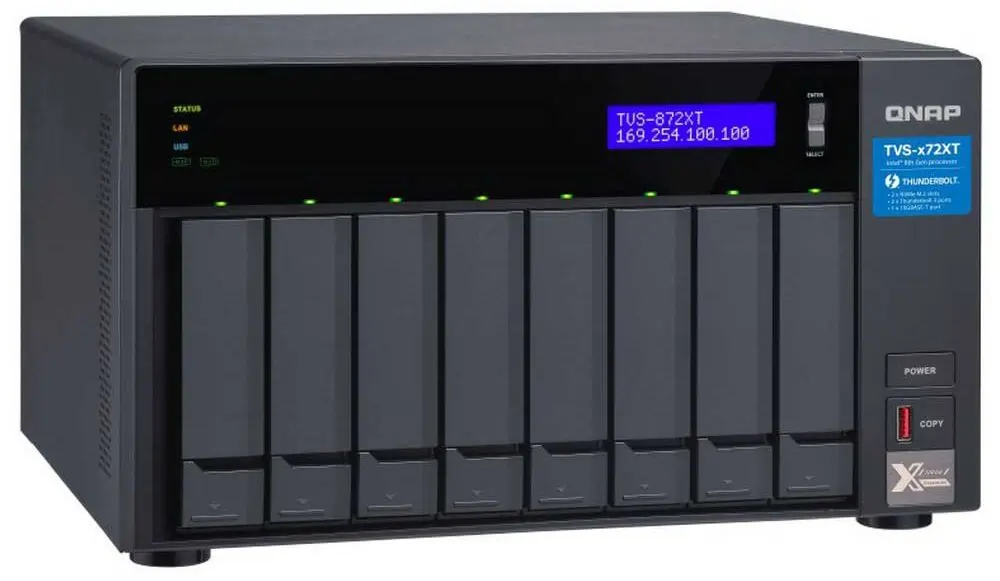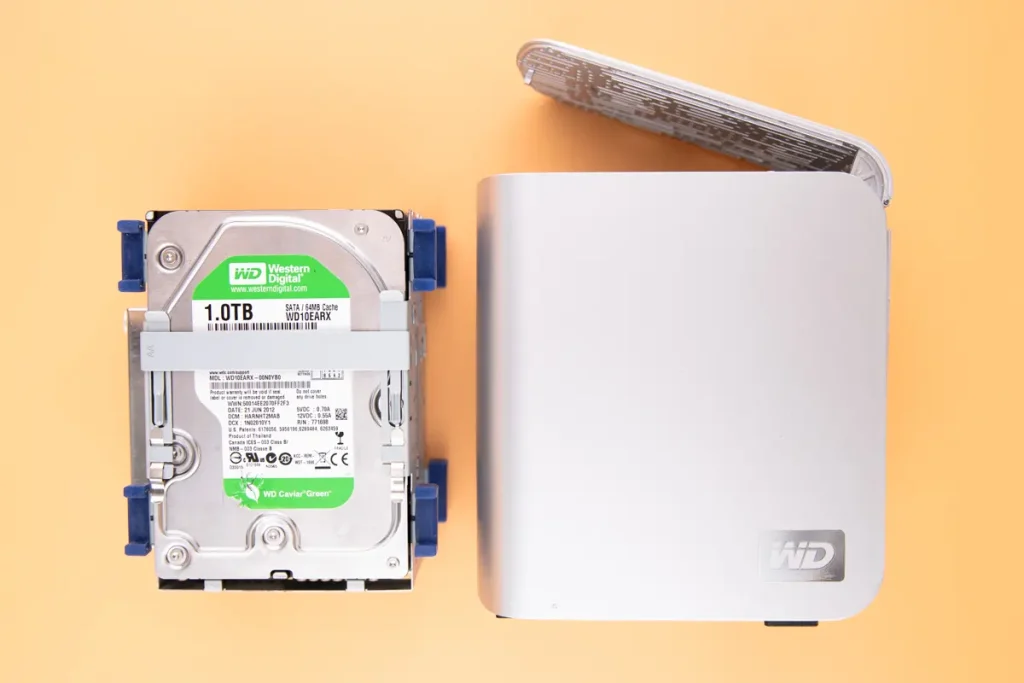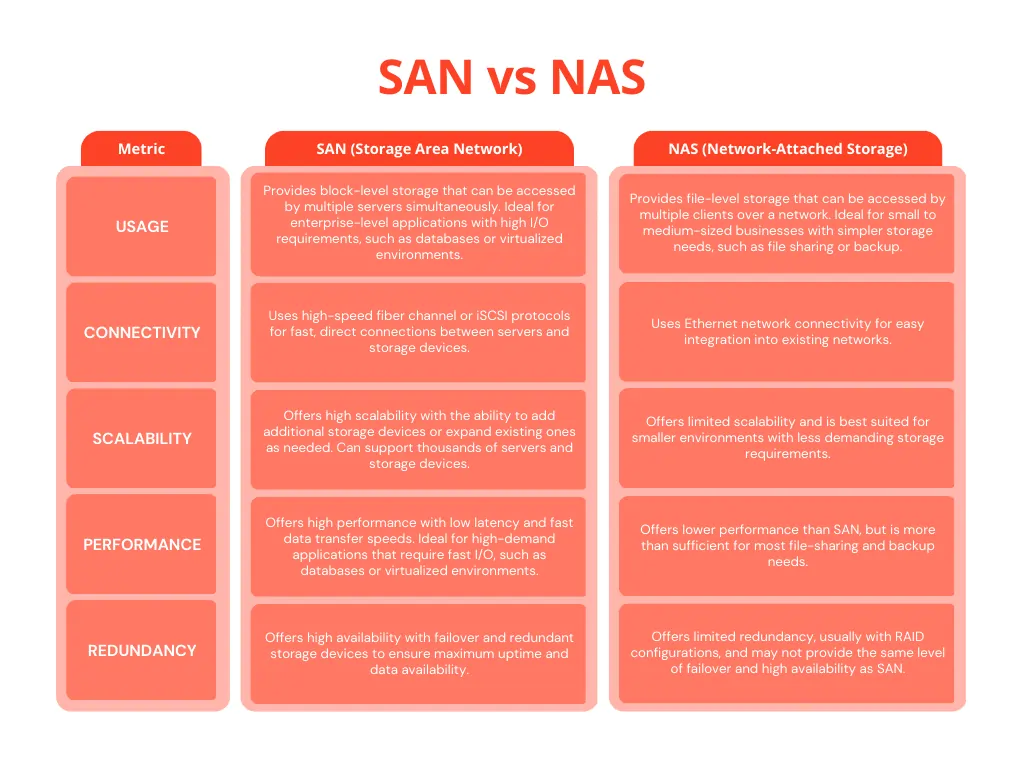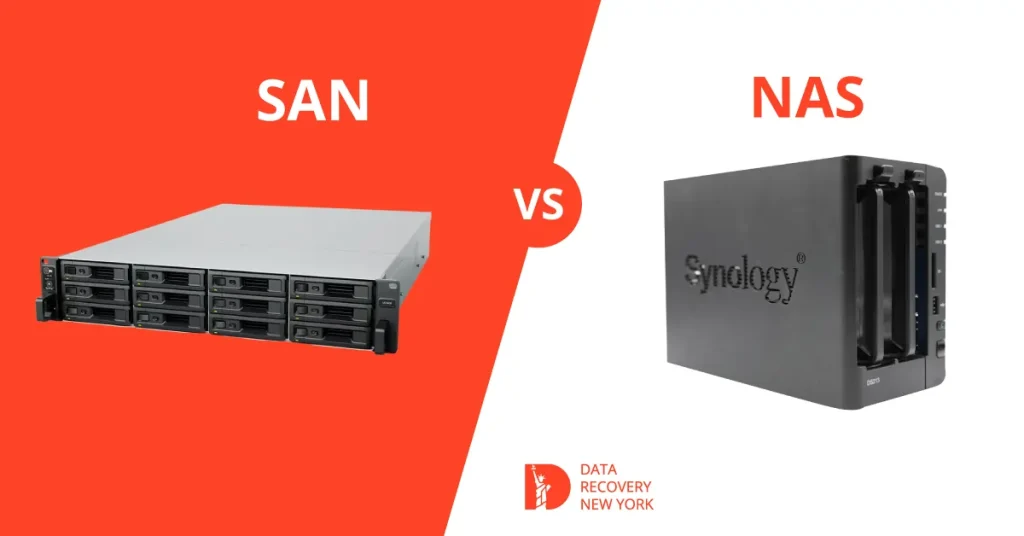SAN vs NAS – we are going try to give you the best information about these environments. Conventional data storage lacks satisfactory information security. Directly connecting external media in the corporate sector is outdated, and storing data on workplace computers isn’t secure. While suitable for personal data, a company’s confidential files demand more protection. Efficient enterprise storage solutions include SAN vs NAS, both designed for networked storage. Assessing their pros and cons helps businesses determine the most suitable data storage option.
What is a Storage Area Network (SAN)?

Basically, a Storage Area Network, or SAN, is like a superhighway for your data, providing a dedicated network to connect and manage storage devices. Think of it as a secure and efficient expressway designed to handle data traffic between servers and storage systems. At this point, we will take a rapid look at the key components of SAN. For this purpose, we have prepared 4 key elements of a SAN environment for your convenience:
Key Components of a SAN
- Servers: These are the data traffic controllers, managing the requests for data storage or retrieval.
- Storage Devices: The actual data warehouses where information is stored, ranging from hard drives to more advanced storage arrays.
- Switches: Similar to traffic signals, switches direct the data flow within the SAN, ensuring it reaches the right destination.
- Fiber Channel Cables: The high-speed lanes that enable quick and reliable data transfer within the SAN.

In summary, a SAN comprises three main components: servers, network infrastructure, and storage. These can be broken down into key elements, including node ports, cabling, interconnecting devices (like FC switches or hubs), storage arrays, and SAN management software.
Why You Should Choose SAN?
Secondly, we should make a decision on why we should use SAN infrastructure. If you have not decided yet, take a look at our top reasons for choosing this:
Performance:
SANs are prepared for high-speed data transfer, making them ideal for applications requiring quick access to large volumes of data.
Scalability:
As your data needs grow, SAN setups manage to easily scale up by adding more storage devices or upgrading existing ones.
Centralized Management:
SANs offer a centralized and efficient way to manage storage resources, simplifying administration tasks.
Data Security:
With dedicated channels for data, SANs provide secure conditions, reducing the risk of data breaches.
After all, prudent management of the Storage Area Network (SAN) is essential for sustaining optimal performance and ensuring its longevity. The scope of SAN management encompasses a spectrum of duties, including configuration, ongoing monitoring, troubleshooting, and strategic capacity planning. Regular monitoring and routine maintenance proactively address potential issues, ensuring a stable SAN environment.
Generally, a Storage Area Network emerges as a key player in the ever-expanding data management landscape, providing the infrastructure needed for efficient, scalable, and secure storage solutions. Whether in large enterprises or virtualized environments, SANs offer a reliable expressway for your data, ensuring it reaches its destination swiftly and securely.
What is a Network-Attached Storage (NAS)?
Network Attached Storage, or NAS, is like having your personal cloud at home or in the office. It’s a dedicated device that connects to your network, providing a centralized hub for storing, sharing, and accessing data. Now, let’s quickly examine the essential components of a SAN as well. For your convenience, we’ve outlined four key facts of a SAN environment:

Key Features of NAS
- Plug-and-Play: NAS devices are user-friendly – easy to set up and use. It’s like having your own storage without the need for extensive technical know-how.
- Centralized Storage: All your files, from photos to documents, reside in one centralized location, accessible to all devices connected to the same network.
- Data Sharing: NAS facilitates easy sharing of files among multiple users. It’s your digital collaboration space at your fingertips.
- Remote Access: Some NAS systems offer the perk of accessing your data from anywhere, turning your NAS into a personal cloud that’s always within reach.
Why Choose NAS?
There are several reasons for opting NAS environment. We have listed them under 4 main headings:
Affordability:
NAS is a cost-effective solution compared to building and maintaining a full-scale server for storage purposes.
User-Friendly:
With intuitive interfaces, NAS devices cater to users of all levels – no tech wizardry required.
Data Redundancy:
Many NAS systems support RAID configurations, ensuring data safety even if one drive decides to take a vacation.
Media Streaming:
NAS can double as a media server, allowing you to stream music, movies, and photos to various devices.
In conclusion, NAS devices provide a user-friendly Plug-and-Play experience, offering easy setup and usage without requiring extensive technical expertise. With centralized storage, all files are conveniently located in one place, accessible to devices connected to the same network. NAS enables seamless data sharing among multiple users, creating a digital collaboration space. Additionally, the remote access feature turns NAS into a personal cloud, allowing users to retrieve their data from anywhere, making it a versatile and accessible storage solution.
Differences between SAN and NAS Storage?
Now that you’ve gained insight into the fundamental differences between SAN vs NAS devices, you’re equipped to navigate the landscape of storage technologies. To further assist you in making an informed decision, we’ve crafted a comprehensive comparison chart highlighting the key features of both storage types: SAN vs NAS.
Delving into the complexities of SAN and NAS technologies, it becomes evident that each serves distinct purposes in storage solutions. The essential contrast between SAN vs NAS lies in their architectures and functionalities. Let’s see together all the differences of SAN vs NAS in detail. Finally, we’ve crafted a user-friendly infographic for a straightforward comparison, utilizing specific metrics tailored to our blog readers’ needs.
Purpose
- SAN: Designed for block-level storage, SAN provides high-speed access to data at the block level, making it appropriate for applications that require rapid and direct access to storage.
- NAS: Geared towards file-level storage, NAS is adept at managing files and folders, making it an excellent choice for centralized file sharing.
Connectivity
- SAN: Connects servers and storage stuffs through a high-speed network, typically using Fiber Channel or iSCSI protocols.
- NAS: Utilizes standard Ethernet connections, operating at the file level using protocols like NFS (Network File System) or SMB (Server Message Block).
Access Protocols
- SAN: Employs block-level access protocols, allowing direct access to raw storage blocks. Applications control data access.
- NAS: Utilizes file-level access protocols, providing a more user-friendly approach for sharing files over the network.
Data Control
- SAN: Offers centralized control over data storage, with more focus on raw storage access. Typically used in scenarios where control at the block level is crucial.
- NAS: Provides simplified data management with a focus on file sharing and access control. Ideal for scenarios requiring easy collaboration and file sharing.
Scalability
- SAN: Easily scalable, making it suitable for growing storage needs. However, expansion might require additional infrastructure planning.
- NAS: Also scalable, often more straightforwardly than SAN, allowing for the addition of NAS devices to expand storage capacity.
Use Cases
- SAN: Commonly used in enterprise environments for applications like databases, virtualization, and high-performance computing where quick and direct access to storage is crucial.
- NAS: Well-suited for scenarios involving centralized file sharing, backup, and multimedia streaming where user-friendly access to files is a priority.
Cost
- SAN: Generally involves higher initial costs due to specialized hardware and protocols.
- NAS: Tends to be more cost-effective, often using standard Ethernet hardware and protocols.
Management
- SAN: Requires more complex management due to its focus on block-level access and specialized networking.
- NAS: User-friendly management, suitable for organizations without extensive IT resources.
In final analysis, while both SAN vs NAS serve as network-based storage solutions, their key differences lie in the level of data access (block vs.file), connectivity, and the specific use cases they are optimized for.
SAN is tailored for applications requiring direct and fast access to raw storage blocks, while NAS excels in centralized file sharing and user-friendly data access scenarios. The choice between SAN vs NAS depends on the specific requirements of the organization and the nature of the applications being used. Hope you liked our SAN vs NAS comparison. Do not forget to take a look our image metrics.

Frequently Asked Questions
What is a Storage Area Network (SAN)?
A dedicated network for efficient data traffic between servers and storage devices, akin to a secure superhighway.
Why Choose SAN?
Optimal for high-speed data transfer, scalability, centralized management efficiency, and enhanced data security with dedicated channels.
What is Network Attached Storage (NAS)?
A dedicated device functioning as a personal cloud, providing a centralized hub for storing, sharing, and accessing data with user-friendly features.
Why Choose NAS?
Chosen for affordability, user-friendly interface, data redundancy through RAID configurations, and the ability to serve as a media server.
Differences between SAN and NAS?
Primary differences include purpose (block-level for SAN, file-level for NAS), connectivity, access protocols, data control, scalability, use cases, cost, and management complexity.

